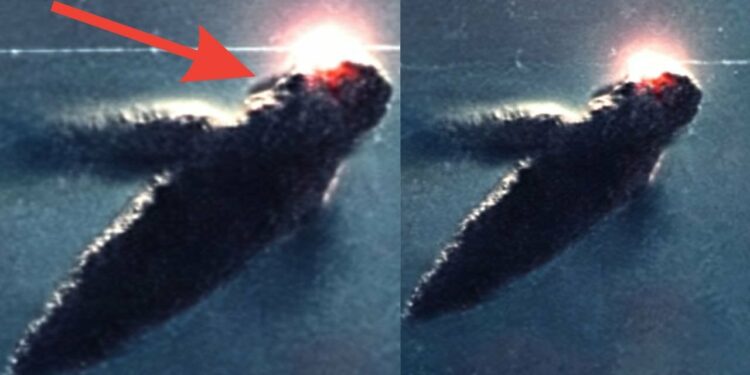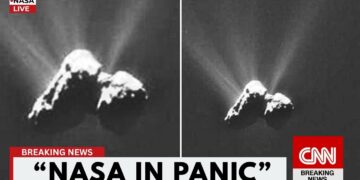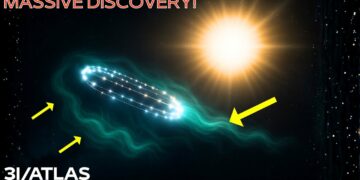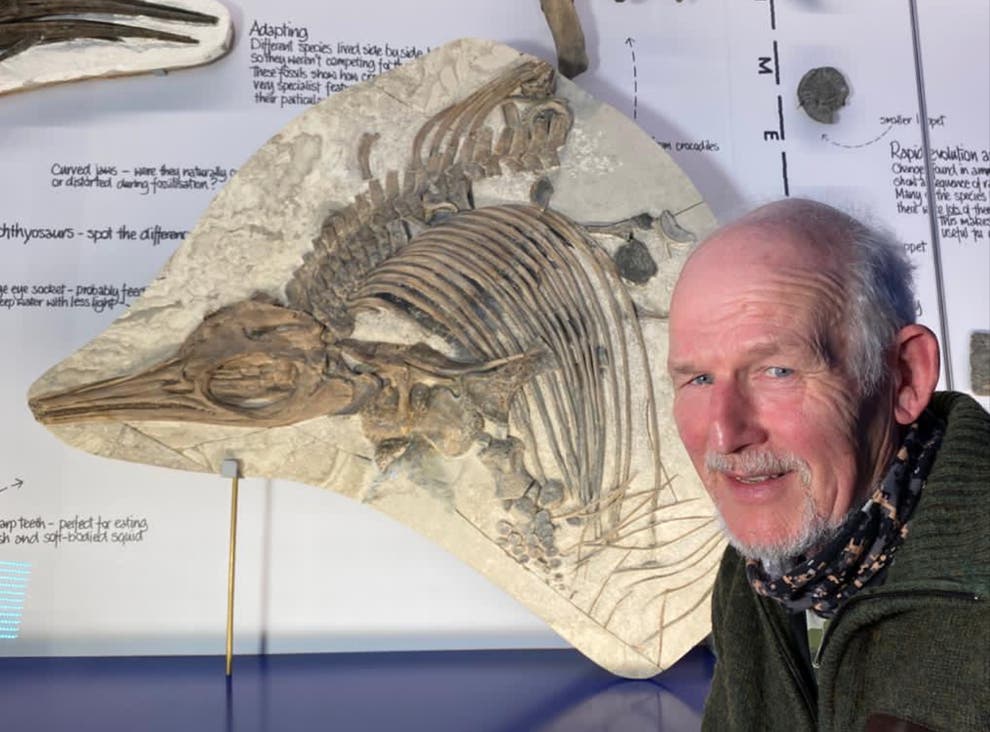What if an interstellar object speeding through our solar system is not a comet but a nuclear-powered spacecraft sent by an alien civilization to observe humanity’s response? A Hubble telescope image lends credence to this idea. While most scientists classify the object, known as Three-Eye Atlas, as a comet from another star system, Harvard astrophysicist Avi Loeb has suggested it could be advanced alien technology, possibly a nuclear-powered spacecraft.
Three-Eye Atlas was discovered on July 1, 2025, by the NASA-funded ATLAS survey using a telescope in Rio Hurtado, Chile. Initially detected as a faint speck of light moving against the backdrop of stars, over 100 observations have provided detailed data on its trajectory. It originates from outside our solar system, is currently inside Jupiter’s orbit, and is heading toward its closest approach to the Sun—perihelion—at the end of October 2025, just inside Mars’ orbit. After this, it will exit the solar system, never to return.
This object has captured the attention of leading scientists, with some, including Loeb, proposing it may not be a natural comet. Its trajectory is highly unusual, moving too fast to be bound by the Sun’s gravity and deviating from typical orbital paths. Loeb notes that Three-Eye Atlas is relatively bright for its distance, suggesting a solid object about 20 km in diameter—twice the size of the asteroid that caused the dinosaur extinction 66 million years ago. Previous interstellar objects, like ‘Oumuamua and Borisov, were much smaller, typically hundreds of meters across. Loeb argues that interstellar space lacks sufficient rocky material to produce such a large object so frequently. More strikingly, its trajectory aligns closely with Earth’s orbital plane around the Sun, a rare occurrence that allows it to pass near Venus, Mars, and Jupiter in a precise sequence, with odds estimated at 1 in 20,000.
Three-Eye Atlas is only the third confirmed interstellar object ever recorded, following ‘Oumuamua in 2017 and Borisov in 2019. Racing toward the Sun at over 133,000 mph (60 km/s), it is the largest and fastest of its kind. Its chemistry appears pristine, untouched for over 7 billion years, predating our solar system. Spectral data reveal water ice, organic molecules, silicates, and carbon-rich material, suggesting it formed in a distant, ancient region of the Milky Way, possibly near its center in the Sagittarius constellation—a region associated with mysterious radio signals, including the 1977 WOW signal.
Unlike typical comets, Three-Eye Atlas exhibits puzzling behavior. It developed a coma—a glowing halo of gas and dust—far from the Sun, at over 4 astronomical units (600 million km), where solar heat is usually too weak to trigger such activity. Even stranger, its tail points toward the Sun, not away, suggesting unusually large, heavy dust particles resistant to solar radiation. Loeb suggests these anomalies, combined with its precise trajectory, could indicate an artificial origin, possibly a spacecraft designed to blend in as a comet. He speculates that its timing—reaching perihelion when Earth is on the opposite side of the Sun—might be intentional, allowing it to perform maneuvers or deploy probes to inner planets while evading close observation.
The discovery of Three-Eye Atlas began quietly in the summer of 2025 at the Cerro Tololo Inter-American Observatory in Chile. The ATLAS survey, designed to detect hazardous asteroids, flagged a fast-moving speck of light unlike anything in our solar system. Orbital models confirmed its interstellar origin, marking it as the third such object ever detected. Unlike ‘Oumuamua, which sparked global debate due to its odd shape and unexplained acceleration, or Borisov, which resembled a typical comet, Three-Eye Atlas initially received little attention. However, its early detection provides a unique opportunity to study it extensively before it leaves the solar system.
Compared to its predecessors, Three-Eye Atlas stands out. ‘Oumuamua, discovered in 2017, was cigar-shaped, showed no coma or tail, and accelerated inexplicably as it departed, leading to speculation about its artificial nature. Borisov, found in 2019, was a classic comet with a bright tail and familiar chemistry. Three-Eye Atlas falls between these extremes, displaying comet-like features but with weak activity and a trajectory that defies random chance. Its early detection, months before perihelion, allows scientists to track its coma, tail, and composition using spectral analysis to identify chemicals like water, carbon compounds, or unusual elements that could hint at its origins.
The object’s size, estimated at 4 to 11 km (though possibly up to 20 km), makes it the largest interstellar object observed, and its brightness aids tracking. However, a significant challenge looms: at perihelion, Three-Eye Atlas will be behind the Sun from Earth’s perspective, rendering ground-based telescopes blind during its most active phase. Fortunately, two spacecraft—ESA’s JUICE mission to Jupiter’s moons and NASA’s Psyche mission to the asteroid belt—will be within 0.3 and 0.44 astronomical units, respectively, during this blackout. With quick planning, these missions could capture images, spectral data, or measurements of the object’s coma and tail, offering a unique perspective.
The revolution in detection technology, driven by surveys like ATLAS, Pan-STARRS, and the upcoming Vera Rubin Observatory, has made such discoveries possible. These systems use wide-field imaging and machine learning to identify fast-moving objects, enabling early detection of interstellar visitors. Unlike ‘Oumuamua, spotted too late for detailed study, or Borisov, observed for only weeks, Three-Eye Atlas offers months of observation time, from August through December 2025, with peak activity expected at perihelion on October 29–30.
Could we send a spacecraft to intercept Three-Eye Atlas? Proposals like Project Lyra, designed to chase ‘Oumuamua, highlight the challenges: its 60 km/s speed far exceeds current spacecraft capabilities, requiring complex gravity assists or advanced propulsion not yet available. With only months until perihelion, launching a new mission is infeasible, but future rapid-response systems could be developed for such objects. The increasing frequency of interstellar detections—three in under a decade—suggests they are more common than once thought, likely due to improved technology rather than a cosmic shift.
Three-Eye Atlas represents a turning point. Its pristine chemistry, precise trajectory, and anomalous behavior challenge our understanding of comets and raise the possibility of an artificial origin. As telescopes worldwide track it and spacecraft prepare for close-up observations, this object could reveal clues about the galaxy’s ancient past—or something far more extraordinary. Whether a time capsule from a distant star or a disguised alien probe, Three-Eye Atlas underscores humanity’s growing ability to explore the cosmos and our place within it.























